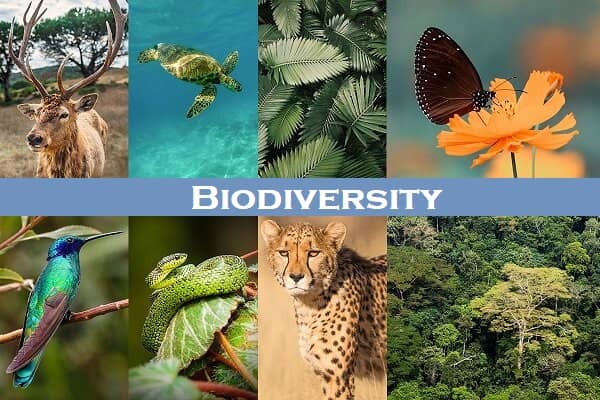MCQ ON BIODIVERSITY class 12 for NEET | BIODIVERSITY class 12 | MCQ BIODIVERSITY with Answer | Check the below NCERT MCQ question for class 12 Biology based on the with Answers.

MCQ ON BIODIVERSITY class 12 for NEET
MCQ on BIODIVERSITY class 12 Biology with answers were prepared based on the latest pattern.We have provided class 12 Biology MCQs questions on BIODIVERSITY with Answers to help students understand the concept very well.
MCQ ON BIODIVERSITY is useful for NEET / CSIR / UGC / CBSE / ICSE / AIIMS / EXAM / AFMC EXAM / STATE LEVEL MEDICAL EXAM 2022-23, 2023-24
Introduction:
If an Alien from a distance galaxy where to visit our planet earth the first thing that would a match and vifal him would most probably be the normal diversity of life that he would encounter. Even for humans the rich varieties of living organisms with which they share this planet never ceases to astonish and fascinates us . In our biosphere immense diversity exist not only other species level but it all levels of biological organisation ranging from micro molecules within cells to biomes. Biodiversity is the term popularised by the sociobiologist Edward Wilson to describe the combine diversity at all the level of biological organisation. The most important of them are genetic diversity, species diversity and ecological diversity. It has taken millions of years of evolution to accumulate this reach diversity in nature but we could lose all the wealth in less than two centuries the present rates of species losses continue. Biodiversity and its conservation are now vital environmental issues of international concern is more and more people around a world begin to the release the critical importance of biodiversity for our survival and well being on this planet.
MCQ ON BIODIVERSITY class 12 for NEET
1. Biodiversity act of India was passed by parliament in
(a) 1992
(b) 1996
(c) 2000
(d) 2002
Ans (d) 2002
2. Most biodiversity rich zone in India is
(a) gangetic plains
(b) trans Himalaya
(c) Western ghats
(d) Central India
Ans. (b) Western ghats
3. A threatened species is
(a) only endangered species
(b) only vulnerable species
(c) endangered and rare species
(d) endangered , vulnerable and rare species
Ans. (d) endangered, vulnerable and rare species
4. Species listed in red data Book are
(a) vulnerable
(b) threatened
(c) endangered
(d) all the above
Ans.(d) all the above
5. Biodiversity is a term popularised by the sociobiologist
(a) Edward Wilson
(b) Odum
(c) Galton
(d) Robert hook
Ans.(a) Edward Wilson
6. Rate list of endangered species is maintained by
(a) CSIR
(b) IUCN
(c) NEERI
(d) WLS
Ans.(b) IUCN
7. Population limited to a particular area is known as
(a) endemic
(b) pandemic
(c) natural
(d) alien
Ans.(a) endemic
8. Introduction of new species in an ecosystem leads to
(a) Amensalism
(b) competition for resources
(c) symbiosis
(d) better development
Ans.(b) competition for resources
9. Which of the following represent maximum number of species among global biodiversity ?
(a) Mosses and ferns
(b) algae
(c) lichens
(d) fungi
Ans. (d) fungi
10. Hotspot is related to
(a) biodiversity
(b) ecological efficiency
(c) Niche
(d) ecological pyramid
Ans. (a) biodiversity
11. Beta diversity is diversity
(a) in a community
(b) between communities
(c) ine mountain gradient
(d) on a plane
Ans.(b) between communities
12. Pickup zone of our country considered as hotspot of biodiversity and regarded as cradle of speciation
(a) North East
(b) Himalayan base
(c) Western Ghat
(d) Deccan plateau
Ans . (c) Western Ghat
13. Distribution of organism in different parts is
(a) geography
(b) biogeography
(c) hydrogeography
(d) zoogeography
Ans.(b) biogeography
14. Causes of biodiversity losses
(a) habitat loss and fragmentation
(b) over – exploitation
(c) alien species inventions and co – extinctions
(d) all the above
Ans. (d) all the above
15. Plant pollinator mutualism where extinction of one invariable leads to extinction of the order are
(a) alien species invasions
(b) Co – extinctions
(c) Over – exploitation
(d) all the above
Ans.(b) Co – extinction
16. The nil perch introduced into Lake Victoria in East Africa is example of
(a) Co – extinctions
(b) Alien species invasions
(c) Over – exploitation
(d) Habit loss
Ans.(b) Alien species invasions
17. Lungs of the planet
(a) Amazon rain forest
(b) Western ghats
(c) conifers
(d) Savannah
Ans.(a) Amazon rain forest
18. Loss of biodiversity in a region may lead to
(a) decline in plant production
(b) Lowered resistance to environmental perturbation such as drought
(c) increase variability in certain ecosystem process
(d) all the above
Ans. (d) all the above
19. According to IUCN red list during the last 2 decades the maximum increase in the number of threatened species is among
(a) mammals
(b) amphibians
(c) reptiles
(d) birds
Ans.(b) amphibians
ALSO READ:-
● YOU CAN WATCH BIOLOGY SIR Youtube channel
20. Concept of hotspot was first introduced by
(a) Mayer
(b) Simpson
(c) Myers
(d) David
Ans.(a) Mayer
21. The objective of ramsar convention was
(a) forest conservation
(b) wildlife conservation
(c) wetland conservation
(d) biodiversity conservation
Ans.(c) wetland conservation







Leave a Comment